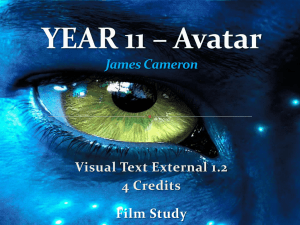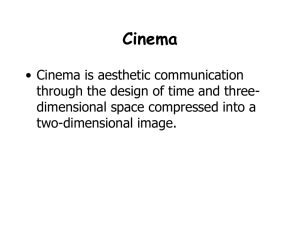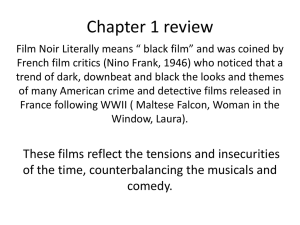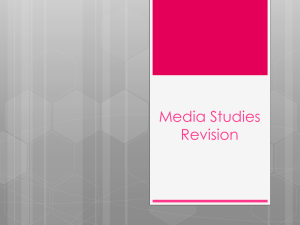4.2 - UO Blogs
advertisement
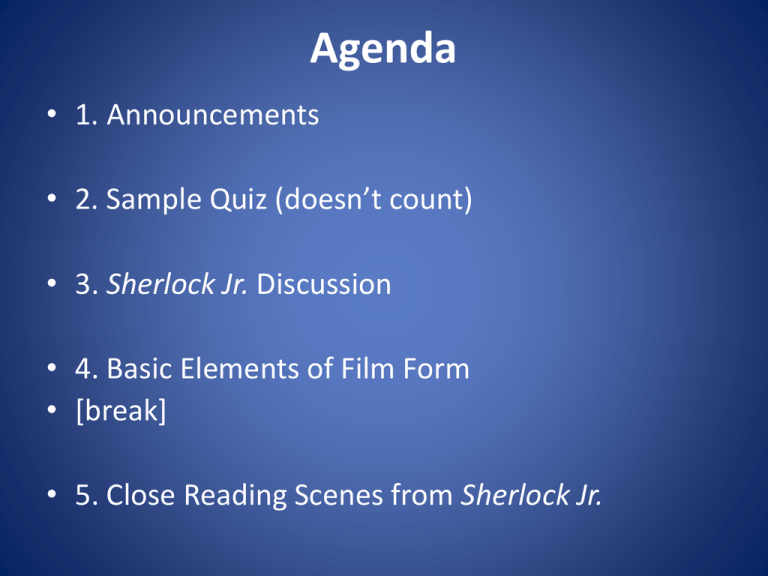
Agenda • 1. Announcements • 2. Sample Quiz (doesn’t count) • 3. Sherlock Jr. Discussion • 4. Basic Elements of Film Form • [break] • 5. Close Reading Scenes from Sherlock Jr. Announcements • Blog: Log in at blogs.uoregon.edu if you haven’t yet • Due Dates: Everything pushed back a week (except final paper) • Textbook: Should be available on reserve soon – DVD: Optional • First Quiz: Next Wednesday Basic Blog Rules • Write about material that is related in some way to our films, readings, or discussions. • Don’t plagiarize (or self-plagiarize). – Hyperlink outside sources (if it was online) as well as anything else that adds to your post. • Use the same courtesy and respect you would use in class discussion. • Proofread • Post on time Blog Assignment • 1). A close reading: Look closely at a scene from one of our films. – You might write about one of its formal properties, like its mise-en-scene. – You could talk about why you thought that scene was important to the overall meaning of the film. – You might talk about how our perception of one particular character is developed in a particular scene. Lots of options here. • 2). A personal response: What does this film make you think or feel? How does it connect to your own experiences? – Show us the dialogue taking place between you and the filmmaker, and how you interpret and make meaning of the work. Make an argument for why the film did or didn’t resonate with you. • 3). A connection: “This film (or the discussion from this week) makes me think of this other thing that is relevant to the course.” – For example, in Week 7 we’ll talk about Through the Olive Trees, a film that responds to a natural disaster. You might talk about that film in relationship to another film about disaster, for example Spike Lee’s When the Levees Broke. Sample Quiz • 1. The camera angle used in a particular shot would be an example of that movie’s content / form. (circle one) • 2. In what decade was Sherlock Jr. released? – A. 1910s – B. 1920s – C. 1930s – D. 1950s • 3. Name one of the four basic approaches to film history described by Barsam and Monahan. • 4. What’s an example of a subject that an early film (before 1900) might depict? • 5. At the end of Sherlock Jr., the main character: – A. Kisses the “girl in the case” – B. Quits his job at the movie theater – C. Solves the mystery of the missing pocket watch – D. All of the above Sherlock Jr. (1924) • “I enjoyed/didn’t enjoy this film because . . .” • What’s the storyline of the film? Is there conflict? Do the characters change? • What did you notice about the form of this film? In what ways is it different from films of today? • What does this film tell us about movies in the 1920s? Is the same true today? What Makes A Film . . . And How Do We Talk About Them? What Is Form? • What separates form and content? • What makes film form different from form in other media (for example, painting or writing)? What are the similarities? • Form is a collection of thousands of choices, large and small – “Very little in any movie is left to chance” (Barsam and Monahan 36) Five Basic Formal Qualities of Film 1. Mise-en-scene 2. Cinematography 3. Editing 4. Sound 5. Narrative 1. Mise-en-scene • The “theatrical” elements of the shot, which are unrelated to the function of the camera. Includes: – – – – Sets and props Lighting Costumes “Blocking” • Questions to ask: – – – – – Where is the shot and what is framed in it (people, objects)? Where do people move? How are the actors costumed? What props or sets can you see? How is the subject lit? 2. Cinematography • Anything related to the manipulation of the camera in the shot. Includes: – Camera movement – Camera placement (or angle) – Manipulations of film or film speed • Questions to Ask: – Where is the camera positioned in relation to the subject? – Is the camera moving? If so, how/where? – Are any film or camera manipulations? (i.e., tinting or slow/fast/stop motion) Describing Shots • Distance: Extreme long shot, Long shot, Medium shot, Close up, Extreme close up • Movement: – Camera Moving on Tripod: Pan and tilt. – Camera Moving in Space: Tracking shot, crane shot. – Camera Stable, Lens Moving: Zoom In, Zoom Out • Angle: High angle, eye level or point-of-view, low angle, bird’s-eye . . . Canted or “dutch angle” 3. Editing • How the different shots in a film are ordered and arranged: where shots are cut, and how different shots are stitched together. • Questions to Ask: – What’s the relationship of this shot to the shots that come before and after it? – What do you think the shot’s purpose is in the sequence? – How does the editor make the transition between shots? (Is it a hard cut? A fade-in? A wipe?) – What’s the pacing of the editing at this point? What’s a Shot? • “One uninterrupted run of the camera” (Barsam and Monahan 545). From the moment a camera turns on to the moment it turns off. • http://youtu.be/qwL1y1uITwg?t=2m42s • Within a single shot, the camera may move or the focus may change. It’s only when the camera turns off that the shot has ended. • http://artsbeat.blogs.nytimes.com/2014/03/27/anatomy -of-a-scene-video-of-the-raid-2/?ref=movies • Shot – Sequence – Scene - Film 4. Sound • Just any sound we hear from the film. Includes: – Dialogue, Sound effects, Music, Voiceover – Diegetic Sound: Occurs w/in the narrative world of the film – Nondiegetic sound: Sound that we imagine only the audience can hear • Questions to Ask: – What sounds do we hear during the shot? Is there music? Dialogue? Sound effects? Voiceover? – Is the sound diegetic or nondiegetic? – Is the sound coming from onscreen or off? – Is the sound continuing from the previous shot, or is it just beginning? 5. Narrative • “A cinematic structure in which content is selected and arranged in a cause-and-effect sequence of events occurring over time” (Barsam and Monahan 542) • Questions to Ask: – What are the major events the film? – How are those events ordered in time? – What events are left out? – What are the film’s beginning and end points? What’s the Difference Between Story, Plot, and Narrative? • Story: The BIGGEST picture – What we imagine takes place in real time, and in real space (even if it’s not depicted on screen) – Objective reality or history • Plot: All the stuff that happens in a movie, as we imagine it in chronological sequence. • Narrative: The way the story and plot are told: – – – – The selection and arrangement of space and time. Some events aren’t depicted Some time is elided, or presented in a nonlinear way We follow certain characters, but not others Formal Analysis Exercise • Group 1: Mise-en-scene • Group 2: Cinematography • Group 3: Editing • Group 4: Narrative Why Do Formal Analysis? For Monday: • Man with a Movie Camera (1929) – Dir. Dziga Vertov • Log in at blogs.uoregon.edu if you haven’t already. Read the blog assignment – first post due by midnight on 4/18. • Download a copy of the revised syllabus so you don’t get confused about dates. • Get ahead for Wednesday: Read Ch. 3 and pages 443-450.

